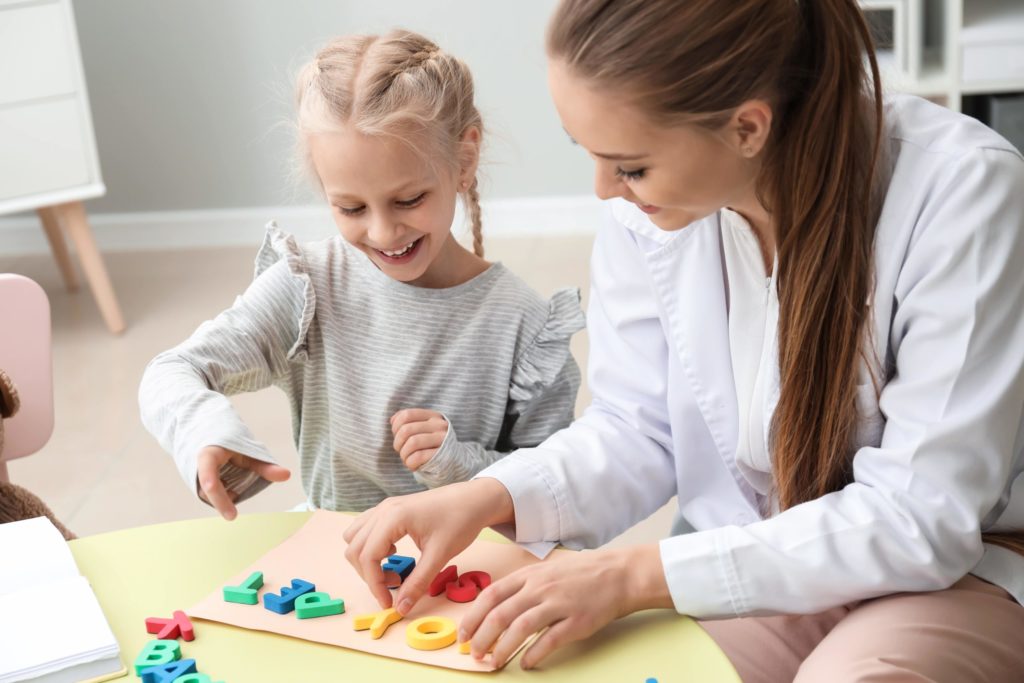- What is ABA Therapy?
- Is ABA effective?
- How ABA Works
- Types of ABA therapy
- Measuring success
- ABA at Attain
- When to start ABA
- Glossary of common ABA terms
APPLIED BEHAVIOR ANALYSIS:
A BEGINNER’S GUIDE FOR PARENTS
Parenting a child with developmental delays is its own, unique journey. There’s so much to learn and understand about your child, the challenges they’ll face, and the support they’ll need over the next few years. A little knowledge can go a long way in helping you feel prepared. Below, we’ve compiled a detailed resource that includes everything you need to know about ABA therapy as you start out on this new path.
WHAT IS ABA THERAPY?
ABA teaches children new skills, behaviors, and coping mechanisms through the power of positive reinforcement. Your child’s clinician will gather data on how your child is responding to each therapy method they try, and based on how they’re progressing, adjust their treatment to match. Through ABA, your child can learn, grow, and develop in a way that works best for them. Your child will gain the much-needed tools to cope with the challenges of having autism and function in a world designed for the neurotypical.
IS ABA EFFECTIVE?
ABA: The Gold Standard
ABA (Applied Behavior Analysis) has proven to be the gold standard for children with ASD and developmental delays. ABA is considered an evidence-based best-practice treatment by the US Surgeon General and the American Psychological Association.
While there are no miracle cures for developmental delays, ABA therapy is the most frequently recommended option for ASD (autism spectrum disorder). It’s the recommended choice of The Centers for Disease Control (CDC), The National Institutes of Health (NIH), and the U.S. Surgeon General. Most major insurance companies and state health agencies, the American Medical Association, and the American Academy of Pediatrics all support ABA.
Proven effectiveness
More than 20 independent studies have established that long-term therapy using ABA principles improves results for children with autism, including in the areas of cognitive, language, communication, daily living skills, and social functioning.
Over the past 40 years, several thousand published research studies have documented the effectiveness of ABA across a wide range of:
- Interventionists: Parents, Teachers, and Staff
- Populations: Individuals with mental illness, developmental disabilities, and learning disorders
- Settings: Schools, homes, institutions, group homes, hospitals, and business centers.
- Behaviors: Language, social, academic, leisure, functional life skills, aggression, self-injury, oppositional, and stereotyped behaviors. Research has shown that the best way to help children on the autistic spectrum is by training them to show positive behaviors and stop the negative behaviors. ABA celebrates and rewards the little steps leading up to the big goals and helps the child reach their full potential.
- 5 factors that make ABA so successful
- Individualized Program: As the parent, you would know this better than anyone else: your child is unique. Through ABA, they get a program designed for them.
- 1:1 Teaching: Providing the extra care and love your child deserves.
- Intensive Hours: Almost daily reinforcement and repetition helps your child truly respond and thrive to treatment.
- Positive Approach: Where desired behaviors are celebrated and encouraged.
- An evolving process: Assessments, evaluations, and reports are constantly referenced to track results and improve.

HOW ABA WORKS
There are no hard and fast rules; ABA is all planned according to your child. Each child is assessed, evaluated, and studied. Then, therapists take the child’s needs, capabilities, and potential and construct a doable ABA plan of treatment. This will help the child reach milestones speedily and keep growing. For example, children under the age of 3 receive a modified form of ABA, which resembles play therapy. As the child reaches the goal behaviors, therapists will take children into real-world settings to discover the behaviors they learned and practice them in social settings. The goal of any ABA program is to help each child work on skills. These skills help them become independent and thrive. At Attain, ABA can be provided in many different settings – at home, at school, and everywhere. ABA follows the ABC steps; Antecedent, Behavior, Consequences. The ABA therapist will keep track and record data of the:
A: Antecedent - An action your child reacts to, such as a request made by the therapist that provokes a specific behavior. I.e., “John, let’s go to the table”.
B: Behavior - The behavior that results from the action done by the therapist. I.e., John refuses and starts resisting.
C: Consequence - This is the response to the behavior, such as positive reinforcement or withholding reward. I.e., John doesn’t earn the toy that’s in the therapist’s hand.
Once these steps are accounted for, our therapists will employ different antecedents and consequences to drive better behavior.- This can mean that the request must be made in a different setting (if the child is not focused or overstimulated.)
- The request has to be made differently (Placing a verbal prompt in place of a modeling prompt or vice versa might be a good idea.)
- The consequence must be changed (If bubbles, candy, or music were an overused reward, the child would not be motivated. The therapist will have to find another method of reward that will excite the child.)
Positive Reinforcement: Attain’s Driving Philosophy
The main caveat to ABA success is the strategy called Positive Reinforcement.
When a behavior is followed by something that is valued, a person is more likely to repeat that behavior. Over time, this encourages positive behavior change. Your child’s individualized care plan breaks down each skill we’re aiming for into small, concrete steps. The therapist then helps your child meet each step one by one, from simple to more complex — like teaching the child to imitate single sounds to eventually say a complete sentence.Segmented steps help your child reach their goals
- First, we identify a goal behavior. Each time your child uses the newly taught skill like following a one-step direction to ‘walk to the door,’ they get a reward. The reward is meaningful to the child – examples include praise, a toy or book, watching a video, access to the playground or other favorite location, and more. Positive rewards encourage the person to continue using the skill. Over time this leads to meaningful behavior change. Attain ABA programs are not "one size fits all." ABA is not a canned set of drills. Instead, it’s a written program that meets the needs of the individual learner.
- The goals that are set are mined for the skill requirements. For example, a child needs to say the word “ball” when they see a ball and want one. When someone asks them, “What do you throw?” or “Show me the thing you hit with a bat?” The child needs to point to or select a ball when shown a group of objects. This careful assessment of the child’s skills reveals the child’s actions and what the RBT still has to teach. The BCBA will develop a plan which focuses on making the child successful.
- The skills that need to be taught are further broken down into small steps. The child is assisted (prompted) to progress through these steps and rewarded (positively reinforced) for even small attempts. Then, the prompts are slowly removed as the child progresses, and positive reinforcement is given less frequently. By continuing in this careful, systematic manner, the BCBA working with the child can get rid of barriers that prevent success. The BCBA will revise the treatment so that the child succeeds.
TYPES OF ABA THERAPY
Here are four primary ways that Attain therapists apply ABA in the daily learning environment.
- Discrete Trial Training: The therapist provides a prompt, asking your child to follow a = desired behavior, and then reward the behavior. This process is then repeated until the desired behavior is displayed autonomously. Ex. Brian is playing with a bit of modeling clay to help him relax. The therapist sits across Brian, holds Brian’s gaze, and says, “put down the clay.” if Brian follows the instructions, he is rewarded with a chocolate chip. (The incentive can be physical contact, tangible items, to anything in between.) Again, the therapist will say, “Brian, put down the clay.” Brian will likely put down the clay because he knows his special reward awaits - his sweet chocolate chip!
- Modeling: Modeling involves demonstrating the desired behavior in ABA therapy. The therapist may provide an in-person, a video, or an audio example of what the individual is expected to do. Laurie sits at a low table with her ABA therapist. The therapist shows her a mini video clip on an iPad of a child jumping up and down and clapping. The video enamors Laurie, and when the video stops, Laurie imitates the action demonstrated in the video. As soon as Laurie does that, she earns a soft cuddle from her therapist. Laurie then watches some more prompts, imitates some more actions, and receives some more incentives. Laurie is having a great time.
- Picture Exchange Communication System: PECS uses pictures to teach communication and vocabulary skills, most commonly to children. The child gives the therapist a picture of the object they want; in exchange, the therapist provides the object. They continue to use this system to communicate new words, phrases, and more. Sara has five cards in front of her with different pictures. A picture of her favorite teddy bear, a cup of juice, M&M’s, a bubble wand, and a sensory toy. The therapist is holding a cup of juice. Sara scans her picture cards and hands the picture of the juice cup to her therapist. She receives her cup of juice and enjoys the refreshing treat.
- Reinforcement Systems: ABA therapists use reinforcement systems to teach children about the consequences of certain behaviors. If the child doesn’t engage in the appropriate behavior, the RBT will prompt them to try again or withhold the child’s reward until they follow through. If they do perform, they receive a reward or positive reinforcement. These 3 ABA techniques use consequences as a means to drive the proper behavior. When the child refuses to obey, oblige, or act upon the request, the request and consequence need to be reevaluated.
MEASURING SUCCESS
ABA therapy requires reliable measurement, which means that it needs a fair and unbiased definition. In this case, vague terms, including depression, aggression, tantrums, and anger, should be redefined in quantifiable and observable terms. This way, their measurable properties, such as their frequency and duration, can be directly documented. Instead of saying, “Karen threw a tantrum.’ Karen’s tantrum becomes “Karen refused the placed demand and kicked her legs and cried for 3 minutes.”Redefining behaviors, measuring the duration, and understanding the reason help the therapist work on new goals and, with time, stop the negative behavior. For instance, the goal is to lessen the aggressive behavior of the child. In this case, "aggression" may be defined as "attempts, occurrences, or episodes separated by ten seconds of scratching, pinching, pulling hair, or biting." On the other hand, initiating interaction with other people may be defined as verbalizing with peers an appropriate greeting.
ABA is a methodology that the BCBA can easily track for data. Therapists typically keep a log to show an increase in positive behaviors and a decrease in negative behaviors, and you can view the results bi-weekly or monthly.
The BCBA and therapists measure progress by collecting data in each therapy session. Data helps them to monitor the person’s progress toward goals on an ongoing basis. The behavior analyst regularly meets with family members and program staff to review information about progress. They can then plan and adjust teaching plans and goals as needed.HOW ABA WORKS AT ATTAIN
At Attain, we harness our national reach, organizational strength, and clinical leadership to attract, train and retain the very best in therapy providers.
Your Attain ABA team includes:
-Your Clinical Director
Every one of our regional clinical directors is a Board Certified Behavior Analyst (BCBA) with a master's or Ph.D. in psychology, behavior analysis, or education, plus a minimum of 10+ years of experience in the field. They apply their knowledge, expertise, and insights into directing Attain’s overarching clinical philosophy, approach, and techniques.
-Your BCBA
Your BCBA develops your child's roadmap of care and personally oversees your (R)BT — and your child's progression throughout the course of therapy.
-Your Behavior Technician
Your behavior technician works one-on-one with your child almost daily. They collaborate with your BCBA and you to implement their roadmap of care and help your child reach their developmental goals, one celebrated milestone at a time.
-Your Care Coordinator
You and your family receive a personal care concierge, who helps you schedule sessions around you and your family's ever-changing schedule. You can reach out to your concierge for anything, anytime.
+You!
As a parent of a child with autism, you are an integral part of your child’s growth. We check in with you often for your input, and to ensure you are in full understanding of your child’s treatment plan and progress. If you ever have any questions, want some clarification, or want to check in, feel free to do so. Our therapists are happy to assist you and your child in their development.
Your child will receive an abundance of positive reinforcement for demonstrating functional skills and socially appropriate behaviors. The emphasis is on positive social interactions and enjoyable learning.
There is no reinforcement for behaviors that pose harm or prevent learning.
At times, we combine ABA with other methods of autism therapy and collaborate with other providers on your child’s team. This can include speech therapy, occupational therapy, and all other methods that help your child develop a range of abilities that will serve them well in life.
WHEN SHOULD YOUR CHILD START ABA?
Like most good things, the earlier, the better. Most parents and clinicians can identify autism in children before they reach 18 months of age. The children that begin ABA therapy before two make the most significant improvements and overcome developmental deficits.
Children who begin ABA therapy as soon as they are diagnosed with ASD make much greater progress.
We want to help your child make progress, learn, develop, and grow. We want to help you as a parent see your child mastering behaviors, and we are committed to helping you. As soon as you receive the diagnosis, it’s ripe time to enroll for game-changing ABA therapy. Attain is devoted to your child’s success.
ABA principles apply to people of all ages. While it may take a little longer to address old habits, whatever the age, the positive results of ABA are tested, proven, and incredible.
ABA TERMS, EXPLAINED
- ASD: Autism Spectrum Disorder is the preferred term used for people with autism. This includes all people on the spectrum.
- ABA: The therapy treatment plan based on: a) understanding the child. b) determining how a child’s actions is influenced by the environment. c) Teaching a child to reduce negative behaviors and practice positive ones.
- Baseline: A baseline represents a child’s behaviors and habits before therapy begins to start gathering data.
- Prompt: Most of ABA therapy is teaching the child to carry out tasks through placed prompts.
- Behavior: the way the child reacts to the prompt is called the behavior. Behaviors can include:
- Verbalizing-laugh, cry, scream.
- Mimicking- Imitate what’s shown or instructed.
- Defiance - resist or throw a tantrum
- Mastery - complete the task successfully
- Lack of behavior - zero reaction to the prompt. - BCaBA: A trained professional in ABA
- BCBA: This person has a Master’s degree in behavior analysis.
- Intervention: A change in the environment, treatment plan, or instructions to change the child’s behavior.
- Extinction: When a child masters a skill and no longer needs reinforcers to complete the task.
- Deprivation: Withholding access to something that the child likes so that the child wants it more and then will carry through a task in order to earn it.
- Functional Behavior Assessment: An assessment where experts learn why a child behaves in a certain way. Our therapists use these four steps: a)Define the behavior. b) Gather information. c) developing an assumption based on research about the cause. d) Make a new plan to change the behavior.
- Reinforcers: A reward for positive behavior brings forth more positive behaviors. Reinforcers are used to encourage the child to perform good behaviors.



